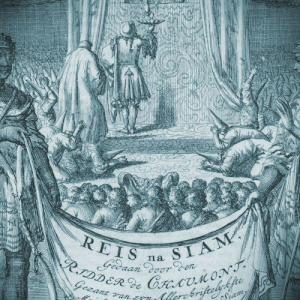Letter from King Narai (r. 1656-1688) in Ayutthaya to the Supreme Government in Batavia, (received) 2 March 1674, and the answer from Batavia, 27 april 1674

Introduced Hendrik E. Niemeijer, Senior Lecturer in Maritime and World History (Diponegoro University, Semarang)
Download the full article in PDF
The letter, which is selected here from the reign of King Narai, dates from ca. October 1673. The reply from the Supreme Government in Batavia Castle to Siam (see next document) is one of the first replies from the Supreme Government that can be found in the VOC-archives in both The Hague and Jakarta. Before 1672 no such letters have been traced so far, and have presumably been lost.
This letter refers to an incident between the Dutch and the English. Although its content is presented in a diplomatic way, it is in fact an angry letter. King Narai was much displeased that the Dutch had taken an English ship, the Philip and Ann, leaving Ayutthaya for Bombay. On board this ship were some diplomatic gifts from the King to the President of the EIC in Bombay. The President, Gerard Aungier, and his Council wrote to the EIC in London that he had received a letter from the Phrakhlang that the King was “much offended at the Dutch for that and their other insolency to the merchants”. [1]
The context is the Third Anglo-Dutch War (early 1672-early 1674), during which England’s Royal Navy joined the French to blockade the Dutch Republic at sea and England’s King Charles II attempted to subjugate the Dutch Republic. The Anglo-French alliance was signed during the secret Treaty of Dover in 1670, which aimed at a punitive campaign against the Dutch Republic. During this campaign, the Dutch Admiral Michiel de Ruyter won several sea battles and the English Parliament forced Charles II to stop the war after two years of fruitless attempts. The year 1672 is known in Dutch history as the “Year of Disaster” (Rampjaar), as in June the French King Louis XIV invaded the Netherlands with an army of 130,000 men.
It is an interesting, but unanswerable, question to ask how far the Siamese King Narai was aware of the specifics of these European treaties and events. The letter from Batavia of 27 April 1674 indicates that it was the duty of the Dutch executive trader in Ayutthaya – at that time Johannes van der Spijck – to inform the court about the Dutch victories at sea. We can imagine that the English and the French in Ayutthaya also presented their information about the Anglo-Dutch War to the court officials.
The French Société des Missions étrangères de Paris (M.E.P.; Paris Foreign Missions Society, established 1658-1663) had already received permission to open the Seminary of Saint Joseph in Ayutthaya in 1666, after the arrival of Mgr Lambert de la Motte and the founding father of the M.E.P., Mgr François Pallu. The high religious tolerance of King Narai was exceptional in those days, and Siam was the only Southeast Asian country where such a Roman Catholic seminary could be found. One of the complaints of King Narai against the Dutch was the Dutch anti-Catholic policy and obstructions to facilitate Catholic missionaries arriving in Banten or Batavia. These hindered the royal correspondence with the French King Louis XIV (r. 1643-1715) and Popes Alexander VII (r. 1655-1667) and Clement IX (r. 1667-1669). King Narai’s foreign policy aimed at the heightening of his prestige by intensifying diplomatic contacts with the most powerful European rulers and spiritual leaders. It is no wonder that during the period 1665-1679 the M.E.P. was able to firmly establish itself in Ayutthaya.
As we have seen in document 22 the English had not considered Ayutthaya as an important trading place since they closed their Hirado factory in 1623. The English trade was centered in Banten, Surat, Madras (Fort St. George, 1640) and after 1668 in Bombay. The English were also far more tolerant than the Dutch towards private or country trade. King Narai usually welcomed English private traders, but the EIC did not open a factory there again until 1675.
In their general letter of 22 December 1675 in Ayutthaya to the E.I.C. in London, the principal English Company representatives wrote that the King “hath bin much abused by private traders”, but had treated the E.I.C. servants “with civillity beyond expactation”. [2] Ayutthaya was a good place to sell Indian textiles and English manufactures. King Narai had promised a share in the tin trade under his seal. The King also gave the English a credit [loan?] of 40 katties of silver, 300 bahar of tin and 1000 pikuls of sappanwood. A few months later the English were hopeful that the King would give the E.I.C. “the same freedome as to buying skinns & goods proper for Japan which the Dutch have”. [3] This makes it very clear that King Narai did not want to depend on exclusive trading relations with the Dutch, but rather maintain his royal monopoly and grant rights to whomever he wanted. Of all Southeast Asian rulers, the Siamese kings played this game with the Europeans the best until King Narai’s foreign and diplomatic policy unravelled in the mid-1680s.
References:
Cruysse, Dirk van der, Siam & the West 1500-1700 (Chiang Mai: Silkworm Books, 2002).
Farrington, Anthony & Dhiravat na Pombejra, The English Factory in Siam 1612-1685 (London: The British Library, 2007), Volume I.
-----
[1] A. Farrington & Dhiravat na Pombejra, The English Factory in Siam 1612-1685, Vol. I, p. 379.
[2] Farrington, The English Factory, Vol. I pp. 394-396.
[3] Idem, p. 407.
Hendrik E. Niemeijer, “Letter from King Narai (r. 1656-1688) to the Supreme Government in Batavia, (received) 2 March 1674, and the answer from Batavia, 27 april 1674” In: Harta Karun. Hidden Treasures on Indonesian and Asian-European History from the VOC Archives in Jakarta, document 23. Jakarta: Arsip Nasional Republik Indonesia, 2016.




